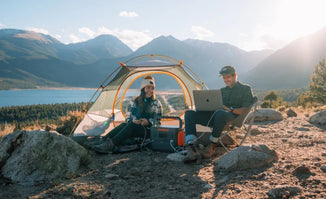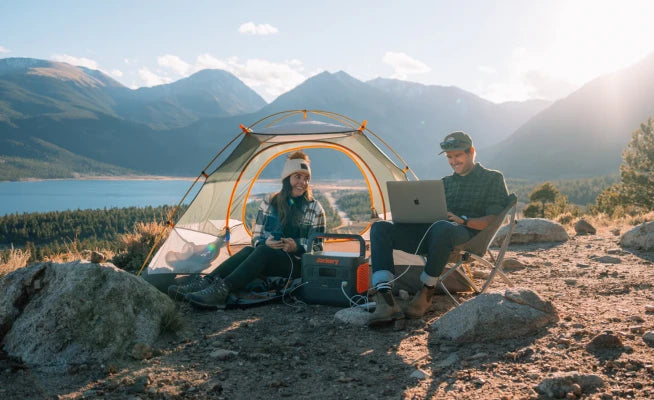The Lake District, a UNESCO World Heritage site, is undoubtedly one of the UK's most breathtaking natural playgrounds. For the solo traveller seeking solace, adventure, and breathtaking natural beauty, it offers an escape like no other.
You'll want to pack light but efficiently, making sure to include essentials like a portable power bank to keep your devices charged as you explore. And at its heart lies Windermere, England's largest lake, serving as the perfect base for exploration.
If you are planning a multi-day solo hiking trip in Windermere, then this 3-day itinerary is crafted specifically for you.
Windermere's Trails: A Heaven for Every Solo Pacer
The varied topography around Windermere provides a rich tapestry of routes, from low-level paths winding through picturesque woodlands to higher fells offering expansive panoramas. This diversity means that solo walkers can tailor their daily excursions to match their mood, fitness level, and the prevailing weather conditions.
Easy & Moderate Walks
For those seeking a more relaxed pace or a gentle introduction to the Lakeland landscape, Windermere abounds with accessible and rewarding options.
The Orrest Head Walk: A local classic, beginning conveniently near Windermere train station.
This well-marked path gently ascends through woodland, offering a peaceful escape and culminating in spectacular views of Lake Windermere and the surrounding fells.
It holds historical significance as the first fell climbed by the renowned hill-walker and author Alfred Wainwright, who found the view "worth the effort of the climb." This short, rewarding ascent is perfect for a quick break from the town's bustle.
School Knott Walk: A circular route easily accessible from Windermere or Bowness
It provides stunning views over Lake Windermere and the distant Langdale Pikes, serving as a tranquil alternative to the often-busier Orrest Head.
The Brant Fell Viewpoint Walk from Bowness-on-Windermere offers panoramic vistas of the lake and is a fantastic option for experiencing natural beauty without a lengthy hike.
Its moderate terrain includes some steep inclines, but the views from Post Knott are highly rewarding.
Lakeside Paths: If you are looking for serene experiences
The Windermere Lake West Shore Walk provides a tranquil route along the water's edge, with lovely views and charming villages. The Windermere to Stock Ghyll Force Walk is a moderate, 6-mile route leading to a captivating 70-foot waterfall near Ambleside, surrounded by lush greenery.
For a combination of countryside charm and history, the walk from Windermere to the National Trust's Townend in Troutbeck village offers picturesque scenery with traditional stone cottages.
The Tarn Hows Circular Walk, a 1.5-mile route, is celebrated for its breathtaking views of hills, tarns, and woodlands, with well-maintained paths suitable for a gentle stroll and abundant photo opportunities.
Challenging Hikes
For solo walkers seeking more demanding adventures, Windermere serves as a gateway to some of the Lake District's iconic fells. While Windermere itself is known for softer, lower hills, excellent links to higher fells to the north are readily available.
The Langdale Pikes
The Langdale Pikes, a short drive from Windermere, offers a challenging exploration through remote terrain, including moderate scrambling, culminating in expansive views over Windermere and Langdale Valleys.
Red Screes
Red Screes, accessible via Kirkstone Pass, presents a more challenging route with rocky paths and steeper climbs, rewarding hikers with breathtaking views from the summit, including Ambleside and the length of Windermere.
The Kentmere Horseshoe
The Kentmere Horseshoe is a classic 13-mile circuit surrounding the attractive hamlet of Kentmere, known for its excellent high-level ridge. While not directly adjacent to Windermere town, its proximity makes it a viable option for those seeking a full-day mountain adventure.
Other Trails Are Waiting for You
The region's connectivity means that even more distant challenging peaks like Helvellyn (951m), Scafell Pike (978m), and Skiddaw (931m) are within reach for ambitious solo hikers, often via public transport connections to starting points further north.
Where Will You Choose to Start?
|
Walk Name |
Difficulty |
Distance (approx.) |
Time (approx.) |
|
Orrest Head Walk |
Easy |
3 km (1.9 miles) |
1-1.5 hours |
|
School Knott Walk |
Easy/Moderate |
6 km (3.7 miles) |
2 hours |
|
Brant Fell Viewpoint Walk |
Easy/Moderate |
3.4 km (2.1 miles) |
1.5 hours |
|
Windermere to Stock Ghyll Force |
Moderate |
9.5 km (6 miles) one way |
3-3.5 hours one way |
|
Loughrigg Fell from Ambleside |
Moderate/Challenging |
8 km (5 miles) |
3-4 hours |
|
Langdale Pikes |
Challenging |
Varies |
Varies |
|
Red Screes via Kirkstone Pass |
Challenging |
8 miles |
5-6 hours |
What to Pack? What to Consider?
While walking in the Lake District offers breathtaking experiences, proper preparation is crucial, especially for solo walkers. The region's conditions can change rapidly, and being prepared reduces risks.
Before setting out, it is paramount to plan the route carefully, utilising maps, apps, and guidebooks to choose a walk suitable for one's ability. For higher fells, planning to be off the mountain before nightfall is essential.
A critical safety measure for solo travellers is to inform someone of the planned route, including estimated time of completion, and to notify them upon safe return. This simple step provides a crucial safety net.
Weather conditions in the Lake District are notoriously variable, even within a short timeframe. Checking the forecast the day before and on the morning of the walk is non-negotiable.
It is advisable to avoid steep and exposed terrain if high winds or storms are predicted, and to be prepared to turn back if conditions deteriorate. High rainfall can make rivers impassable and paths slippery.

Essential gear for every adventure includes:
1. Waterproof jacket and over-trousers for sudden weather changes.
2. Insulating and breathable layers, including a hat and gloves, even in summer, as temperatures can drop quickly.
3. Comfortable walking boots with good tread for ankle protection and grip on varied terrain. Trail runners can also be a good option for less technical paths.
4. Food, water, and a warm drink, plus emergency high-energy snacks.
5. A fully charged mobile phone is vital, but a map and compass (and the knowledge to use them) are indispensable, as GPS signals can be unreliable.
6. A first aid kit and a survival bag are recommended for added security. Walking poles can also aid balance and reduce stress on joints.
Don’t Forget to Bring Yourself A Power Station
If you are planning a livestream, FaceTime your families, or simply taking some images of everything meaningful, then bring a lightweight power station. Consider the Jackery Explorer 240 v2 Portable Power Station and the Jackery Explorer 300 Plus Portable Power Station.
Jackery Explorer 240 v2 Portable Power Station:
Weight: Approximately 3.6 kg (7.94 lbs).
Capacity: 256Wh.
This unit is quite compact and relatively light for a portable power station of its capacity. For short walks or day hikes, especially if you plan to stay in accommodation with mains power at night, it could be a good option.
It would be excellent for charging your phone, headlamp, camera batteries, and perhaps a small GPS device. If you're doing a single-day walk and returning to your base, carrying this in a comfortable daypack isn't unreasonable.

Jackery Explorer 300 Plus Portable Power Station
Weight: Approximately 3.75 kg (8.27 lbs).
Capacity: 288Wh.
Similar to the Jackery Explorer 240 v2 Portable Power Station, this is also designed for portability. The slight increase in weight and capacity offers a bit more juice for your devices. Again, for day hikes or if you're staying on a fixed base, it's certainly manageable.

# My 3-Day Lake District Walking Holidays

Landscape images from Andrew Walks & National Trust
Day 1: Panoramic Views and Classic Lakeland Fells
Proposed Walk: Orrest Head & Brant Fell (a strategic combination to offer diverse panoramic views and a manageable moderate challenge).
Orrest Head
Orrest Head is an iconic walk, famously the first fell walked by Alfred Wainwright, inspiring his lifelong love for the Lake District. The walk is approximately 1.5 miles (2.4 km) round trip or 3.5 km, typically taking 30-45 minutes to reach the summit, with the full walk around 1 hour to 1 hour 20 minutes.
It is generally considered easy to moderate, featuring a steady uphill section. The fully tarmacked track makes it notably accessible for various abilities. The summit is at 238m (781ft), with a height gain of 167m.
The path winds through beautiful woodland and open fields with grazing sheep, culminating in a rocky outcrop at the summit. From the summit, breathtaking panoramic views of Windermere Lake (England's largest natural lake), the distant Langdale Pikes, and on clear days, even Coniston Old Man and Helvellyn are visible.
The villages of Bowness and Ambleside, the Howgill Fells, and Morecambe Bay can also be observed. The walk conveniently starts and ends in Windermere village, close to the train station. Parking is available at Rayrigg Road Car Park (LA23 1BZ) or Windermere Train Station Car Park (LA23 1AH). The area is well-connected by bus services.
Brant Fell
Brant Fell offers a different, equally rewarding perspective over the lake and the bustling village of Bowness. The walk is approximately 1.5 miles or 2.5 km- 2.6 km, typically taking around 1 hour.
Its difficulty ranges from easy to moderate, involving a fairly steep initial climb. The peak is at 192m, with a height gain of 125m. The walk begins just off the main high street in Bowness.
It features a winding path through attractive woodland leading to the viewpoint at Post Knott and offers opportunities for "rock hopping". It provides spectacular views of Windermere Lake over the trees and distinct views over Bowness village itself.
The walk starts in Bowness on Brantfell Road and can be integrated into a larger Bowness Circular Walk.
Day 2: Tranquil Western Shores and Historic Charm
Proposed Walk: Claife Heights to Wray Castle.
This linear trail can vary in length: from 4 miles (6.4 km) to 8 miles (12.8 km), a full trail of 7.5 miles (12 km), or an 8km (4km each way) stroll. A shorter, easy 3-mile (4.8km) circular walk along the west shore and up through Claife Heights is also an option.
The 7.5-mile trail is estimated to take 4-5 hours, while the shorter 3-mile walk takes approximately 1 hour to 1 hour 45 minutes.
The difficulty is generally described as easy with gentle inclines. However, some sections can be moderate to challenging due to steep slopes, rough paths, and uneven terrain.
The 3-mile walk has an ascent of 100m (328ft) or 425 feet. The Cockshott Point to Claife Viewing Platform section has a height gain of 58m.
This walk traverses the peaceful, undeveloped western shoreline of Windermere, offering a tranquil escape from the busier eastern side. The paths are generally well-defined, winding through charming woodlands with intermittent views of Windermere through the trees.
Points of interest along this route include:
- Claife Viewing Station: A fascinating 18th-century historic platform, specifically built to frame and enhance views across the lake, featuring unique stained-glass panels that recreate Victorian-era perspectives.
- Windermere West Shore: A serene lakeside path, perfect for quiet contemplation, with frequent benches for resting and admiring the views.
- Wray Castle: A striking mock-Gothic fortress built in the 1840s, offering architectural interest and further amenities. It also has a café and toilets.
- Windermere Ferry: A practical and scenic way to cross the lake, connecting Bowness to the western shore. Both car and pedestrian/cyclist ferries operate.
Day 3: Valley Vistas and Traditional Village Life
Proposed Walk: Windermere to Townend/Troutbeck Valley (a moderate circular walk offering a blend of valley scenery, historical sites, and fell views).
This route has variations: a 7-mile (11.27 km) circular walk, an 8-mile (12.8 km) full trail, or a shorter 4-mile (6.4 km) option. A 7.4-mile (11.9 km) circular walk that includes Orrest Head is also noted.
The longer routes typically take between 2 hours 30 minutes and 4 hours 30 minutes, with some estimates at 2+ hours. It is rated as moderate.
Individuals should be prepared for uneven and potentially muddy terrain, and a steep climb on rocky tracks during the return journey for the longer routes.
While not explicitly stated for all routes, the walk involves ascending into the Troutbeck Valley and offers views from higher vantage points, potentially including Wansfell Pike.
Points of interest along this route include:
- Townend: A captivating 17th-century traditional farmhouse located in the tranquil Troutbeck village. It provides a fascinating glimpse into local life, preserving the belongings and extensive library of the Browne farming family, which is of international historical importance. It was also Beatrix Potter's favourite place.
- Troutbeck Village: A picturesque village featuring quaint cafes and coffee shops, ideal for a refreshment stop. Jesus Church is notable for its beautiful stained glass windows by Sir Edward Burne-Jones and William Morris.
- Lake Windermere Views: Throughout the walk, excellent vantage points offer sweeping views of England's largest lake.
- Wain Lane: An ancient 10th-century cart lane, historically used by packhorses to transport slate.
- Herdwick Sheep: Keep an eye out for these hardy, iconic Lake District sheep, often spotted grazing on the fells.
- Garburn Pass: From tracks leading towards this pass, expansive views over the Troutbeck Valley can be enjoyed.
(Knocking Wood) If Anything Happened, What Should I Do?
In the rare event of an emergency, dialling 999 or 112 and asking for "Police" then "Mountain Rescue" is the correct procedure.
Providing location details, including a grid reference if possible, is crucial. The emergency SMS service (register by texting 'register' to 999) is available for those with speech or hearing issues, or in areas with intermittent signal where a text might go through when a voice call cannot.
Remaining in place until Mountain Rescue contacts you is important. These preparations empower solo walkers to confidently embrace the challenges and rewards of the Lake District's magnificent landscape.
Waiting for Your Sharing
Glad that you can have a break. Don’t forget the Jackery solar generator, we will be your power safeguard all the time!

































































































